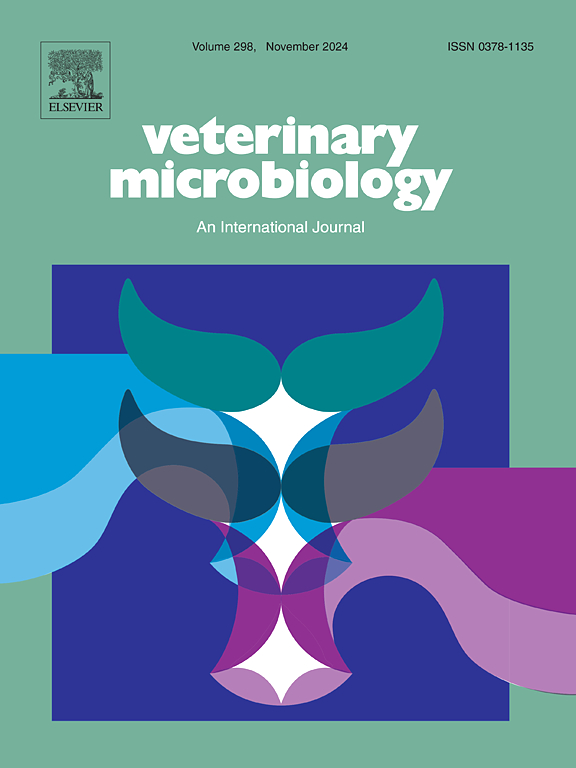CYLD通过去泛素化VP1抑制传染性法氏囊病病毒复制
IF 2.7
2区 农林科学
Q3 MICROBIOLOGY
引用次数: 0
摘要
圆筒状瘤病(CYLD)是一种去泛素酶(DUB),从特异性酶解物中去除k63连接的泛素链,负性调节多种信号通路,包括NF-κ B,这与多种癌症有关。近年来,CYLD在抗病毒免疫中的作用已引起人们的关注,但其在感染性法氏囊病病毒(IBDV)感染中的作用尚不清楚。通过共免疫沉淀结合质谱分析,我们确定CYLD是与IBDV VP1结合的DUB。在IBDV感染的DF-1细胞中,CYLD过表达显著抑制IBDV复制,而CYLD敲除或敲低则增强IBDV复制。有趣的是,这种作用并不通过干扰素途径发生。同时,我们还发现IBDV感染作为一个触发器,在体内和体外环境下都可以上调CYLD的表达。进一步研究表明,CYLD特异性消除VP1的k63连接的泛素链,降低VP1聚合酶活性,从而抑制病毒复制。此外,我们发现C602是CYLD的USP结构域的关键催化残基,影响其酶活性并决定其与VP1的相互作用。至关重要的是,病毒核心蛋白VP3通过破坏CYLD-VP1相互作用来对抗cyld介导的去泛素化,从而促进病毒复制。我们的研究结果证明了CYLD在抗病毒免疫中的重要功能,并表明它是IBDV感染的潜在治疗靶点,特别是通过VP3-CYLD-VP1轴。本文章由计算机程序翻译,如有差异,请以英文原文为准。
CYLD suppresses infectious Bursal disease virus replication by deubiquitinating VP1
Cylindromatosis (CYLD), a deubiquitinase (DUB), removes K63-linked ubiquitin chains from idiosyncratic zymolytes, negatively regulating multifarious signaling channels, including NF-κ B, which is implicated in various cancers. Recently, the role of CYLD in antiviral immunity has gained attention, but its involvement in infectious Bursal diseases virus (IBDV) infection remains unclear. By coimmunoprecipitation combined with mass spectrometry analysis, we identified CYLD as a DUB bound to IBDV VP1. In IBDV-infected DF-1 cells, CYLD overexpression significantly inhibited IBDV replication, whereas CYLD knockout or knockdown enhanced it. Interestingly, this effect does not occur through the interferon pathway. At the same time, we also found that IBDV infection, as a trigger, can upregulate CYLD expression in both in vivo and in vitro environments. Further studies showed that CYLD specifically eliminated the K63-linked ubiquitin chains of VP1 and reduced VP1 polymerase activity, thereby inhibiting viral replication. Additionally, we identified C602 as a critical catalytic residue in CYLD's USP domain that affects its enzymatic activity and decides its interaction with VP1. Crucially, the viral core protein VP3 antagonized CYLD-mediated deubiquitination by disrupting the CYLD-VP1 interaction, thereby promoting viral replication. Our results demonstrate the significant function of CYLD in antiviral immunity and suggest it as a potential therapeutic target for IBDV infection, specifically through the VP3-CYLD-VP1 axis.
求助全文
通过发布文献求助,成功后即可免费获取论文全文。
去求助
来源期刊

Veterinary microbiology
农林科学-兽医学
CiteScore
5.90
自引率
6.10%
发文量
221
审稿时长
52 days
期刊介绍:
Veterinary Microbiology is concerned with microbial (bacterial, fungal, viral) diseases of domesticated vertebrate animals (livestock, companion animals, fur-bearing animals, game, poultry, fish) that supply food, other useful products or companionship. In addition, Microbial diseases of wild animals living in captivity, or as members of the feral fauna will also be considered if the infections are of interest because of their interrelation with humans (zoonoses) and/or domestic animals. Studies of antimicrobial resistance are also included, provided that the results represent a substantial advance in knowledge. Authors are strongly encouraged to read - prior to submission - the Editorials (''Scope or cope'' and ''Scope or cope II'') published previously in the journal. The Editors reserve the right to suggest submission to another journal for those papers which they feel would be more appropriate for consideration by that journal.
Original research papers of high quality and novelty on aspects of control, host response, molecular biology, pathogenesis, prevention, and treatment of microbial diseases of animals are published. Papers dealing primarily with immunology, epidemiology, molecular biology and antiviral or microbial agents will only be considered if they demonstrate a clear impact on a disease. Papers focusing solely on diagnostic techniques (such as another PCR protocol or ELISA) will not be published - focus should be on a microorganism and not on a particular technique. Papers only reporting microbial sequences, transcriptomics data, or proteomics data will not be considered unless the results represent a substantial advance in knowledge.
Drug trial papers will be considered if they have general application or significance. Papers on the identification of microorganisms will also be considered, but detailed taxonomic studies do not fall within the scope of the journal. Case reports will not be published, unless they have general application or contain novel aspects. Papers of geographically limited interest, which repeat what had been established elsewhere will not be considered. The readership of the journal is global.
 求助内容:
求助内容: 应助结果提醒方式:
应助结果提醒方式:


